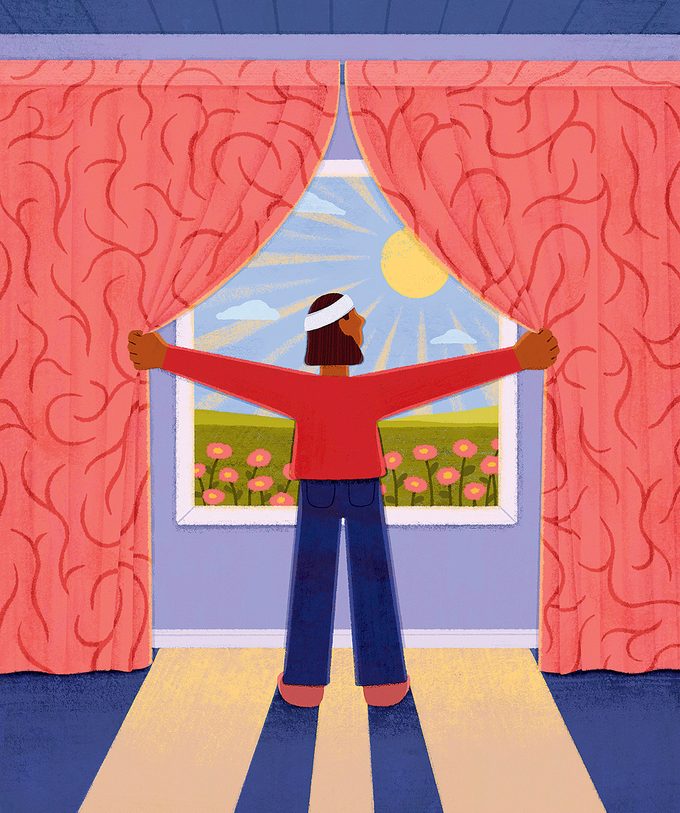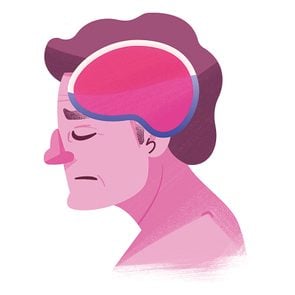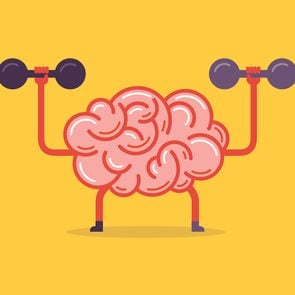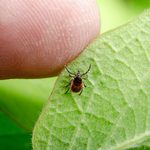“Dark Room” Concussion Treatment Was Wrong—Here’s a Better Way to Recovery
Doctors once prescribed resting in the dark as a treatment for concussions. But recent research shows there is a better approach: active rest.

After suffering a concussion in January 2023, Nicolle Weeks spent nearly a year fighting symptoms such as migraines, fatigue and dizziness. Initially, the 43-year-old didn’t realize how severely she had hit her head.
“I was walking on the sidewalk, and I slipped on some black ice, fell backward and bounced my head off the ground,” she says. She lay flat on her back with her arms out for a minute in shock.
Satisfied she wasn’t injured, she dusted herself off and hurried to meet a friend for brunch. While there, she felt far away and dazed when her friend was talking. But it went away, and she didn’t think much of it.
It wasn’t until one week after her fall that Weeks was officially diagnosed with a concussion. That delay in treatment could be one of the reasons her symptoms persisted for so long.
Previously, doctors prescribed the “dark room” treatment—total rest in the dark while avoiding all mental stimulation. But thanks to recent research, we now know that too much rest and isolation can be harmful for recovery and that the best approach is somewhere in the middle: active rest. This slow and progressive return to activity helps patients recover faster and lessens the risk of long-term damage.
Here’s what doctors have learned, and what you need to know.
What happens during a concussion?
The brain is protected by shock-absorbing fluid and, outside that, the skull. In a concussion, the brain bounces around in the skull, accelerating, decelerating or rotating. This creates a cascade of impacts. The neurons in the brain are rattled, and between those neurons, the axons—thin fibres that transmit electrical impulses—stretch or break. The impact can also decrease blood supply to the brain and damage the neurons’ mitochondria, which create energy.
Inside the brain, it’s like an earthquake has happened. Everything is still standing, but there are cracks in the roads and in building foundations.
This microscopic damage has big consequences—that’s why a concussion is also known as a traumatic brain injury. The brain spends a lot of energy trying to repair itself and, combined with the decreased blood supply and mitochondrial damage, this causes extreme fatigue. Other symptoms may follow, like headaches, memory problems, irritability, insomnia and trouble with balance and visual processing.
Decades ago, the public had a “walk it off ” attitude toward concussions. That’s changed, thanks in part to an increased awareness about the long-term effects. The 2015 film Concussion tells the true story of Dr. Bennet Omalu, a forensic pathologist studying chronic traumatic encephalopathy (CTE), a brain disorder caused by repeated head injuries. CTE causes cellular degeneration in the brain and symptoms such as impaired judgment and dementia.
The disease can only be confirmed during a post-mortem autopsy. In recent years several former NFL players have been found to have had it, including former Denver Broncos player Demaryius Thomas and former New York Giants player Frank Gifford. Last June Henri Richard, a former NHL player for the Montreal Canadiens and Hockey Hall of Famer, was posthumously diagnosed with CTE. He died from Alzheimer’s disease in 2020.
Even though they’re the most high-profile examples, professional athletes aren’t the only ones who suffer from concussions. Each year, about 400,000 Canadians get concussions. Among those aged 20 to 64, 30 percent of concussions are the result of a fall, followed by sports (21 percent), work-related incidents (15 percent) and automobile accidents (11 percent). Among Canadians 65 and older, falls are by far the most common cause, at 61 percent.
The end of the dark-room theory
The dark-room treatment, which until recently was the standard prescribed by most doctors, involved patients resting in darkness and without any mental stimulation, until their symptoms subsided. This suggestion came out of studies in the 1990s and early 2000s that found when athletes with concussions continued with high levels of activity, they recovered more slowly than those who rested.
After a concussion, the brain uses a lot of energy for recovery—that’s why a common symptom is fatigue. So doctors and researchers concluded that doing as little as possible, both cognitively and physically, would free up energy for the brain to fix itself.
But people who spend more time in a dark room—sometimes called “cocooning”—are also more likely to experience anxiety, depression and sleep problems. Their bodies get weaker due to underuse, as well.
Additional research began to show that moderate levels of activity might be more beneficial. A 2008 study published in the Journal of Athletic Training found that athletes who did moderate amounts of activity after a concussion, such as returning to school and going back to sports practices, performed better on tests of their memory, reaction time and visual motor speed than both those who exerted themselves more and those who did very little. More studies followed supporting the idea that there is a sweet spot in terms of post-concussion activity.
Active rest: The stepped solution
“Science and research have evolved over the past decade, showing that when you stop doing activity altogether, that actually hinders your recovery process,” says Shelina Babul, a sports-injury specialist and clinical associate professor in the department of pediatrics at the University of British Columbia. The active-rest approach to concussion recovery promotes a slow increase in activity, starting with a day or two of light daily movement, and gradually adding activity, building to a full return to normal, unrestricted activity.
Despite this new research, much of the public—and even many doctors—still don’t know about the new best practices for concussions, says Babul. That’s why she created a four-step Concussion Awareness Training Tool. “I have amazing research colleagues,” she says. “But it takes an average of 15 to 17 years for scientific research to get from bench to bedside”—to make it from the lab into everyday use by doctors, in other words.
The training tool, which is intended to educate the public, physicians, caregivers and coaches, includes progressive plans for people to get back to their everyday lives. People who have a concussion should always go see their family doctor. Then they can work together through the four steps.
Step one should be observed for a maximum of 24 to 48 hours. Patients are encouraged to sleep, avoid screens and driving, and continue to perform regular activities at home, such as housework and light walking.
At step two, patients can resume light-to-moderate aerobic activity, such as stationary cycling, brisk walking and gardening, and they can gradually reintroduce screens.
Once a patient can tolerate moderate aerobic activity, they can move to step three, which involves returning to work or school and resuming most of their normal activities—except for sports that might give them another concussion through a head impact. If doing those normal activities causes their concussion symptoms to return, they should stop and try again the next day. Finally, at step four, once they can do all that and have clearance from a health-care professional, patients can go back to normal, unrestricted activity, including playing sports.
The goal is to keep people in their window of tolerance, says Babul. Doing too much too soon can push their brain into overload, so it’s important for people to listen to their body.
Dr. Charles Tator is a neurosurgeon and the director of the Canadian Concussion Centre in Toronto. He was made an Officer of the Order of Canada and a member of the Canadian Sports Hall of Fame for his work on concussions and safety in sport.
Tator suggests limiting alcohol and staying away from cannabidiol (a cannabis product). “It seems to prevent the production of the good chemicals in the brain from doing their job,” he says.
Getting good sleep can also help, which might mean staying away from caffeine or tweaking your sleep hygiene. People who have been concussed are also more likely to have sleep apnea, says Tator, and should be evaluated for the condition if it’s suspected.
Long-term effects
“Recovery from concussion is not as quick as we used to think it was,” says Tator. While we now know that most people will recover in roughly four weeks, an estimated 30 percent of people will experience symptoms for longer. For some, the symptoms can even be permanent.
“No two concussed patients are the same in terms of the number of symptoms, the type of symptoms and their recovery potential,” says Tator. “Each person requires individualized care, and it’s usually from more than one health-care professional.”
People who experience vertigo as a major symptom, for example, need to see a vestibular physiotherapist, while anxiety, depression or post-traumatic stress disorder would be treated by a mental health specialist.
Other factors that affect recovery include the force of the impact and whether you’ve had a concussion before. Having more than one increases your risk for permanent damage.
More than a year after her concussion, Weeks is back to her busy life. But she still has some symptoms, such as headaches and dizziness. She wishes she had recognized the signs of a concussion sooner and can’t help but feel that a slow and stepped approach would have made a difference in her recovery.
That’s why education and awareness are so important, says Babul. “People who follow the right guidance and management tend to recover uneventfully, and those who don’t and continue to do their activities continue to tax their brain and are likely to have long-term, persisting symptoms,” she says. “The key is to recognize it immediately and know what to do.”
Next, here are 7 concussion symptoms you should never ignore.






